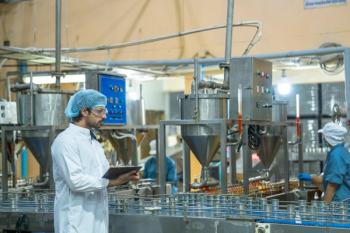
The Role of Spectroscopy in Decoding Peanut Chemistry
Key Takeaways
- The study elucidates the molecular mechanisms of ARA–RES interaction, highlighting hydrophobic forces as primary binding drivers.
- Spectroscopy techniques confirmed that RES enhances ARA stability without altering its secondary structure.
A new study reveals that resveratrol binds to peanut protein arachin through hydrophobic and hydrogen-bond interactions, enhancing protein stability and offering valuable insights for developing functional peanut-based food products.
A recent collaborative effort between researchers from Chinese and American institutions yielded new molecular insights into the proteins and small bioactive molecules in peanuts. This study, which was published in the journal Food Chemistry, investigated the interaction between arachin (ARA), which is the primary storage protein in peanuts, and resveratrol (RES), which is a bioactive compound found in peanuts that is known for its antioxidant properties (1). The findings presented in this study allow us to understand the molecular mechanisms governing the ARA–RES complex, providing a theoretical foundation for developing novel peanut-based functional foods and nutraceuticals.
Why is it important to study the interactions between proteins and small bioactive molecules?
Studying the interaction between proteins and small bioactive compounds is of interest for many industries for different reasons. In drug discovery, for example, understanding these interactions can provide insight on gene regulation and RNA processing, which can help scientists understand the formation of genetic diseases and developmental disorders (2). In food analysis, the interaction between proteins and small bioactive molecules plays a critical role in determining the nutritional and functional properties of food systems (1).
Despite extensive research on peanut proteins and polyphenols, the specific mechanism by which ARA interacts with RES has remained poorly understood. To help shed light on this issue, the researchers combined multispectral analysis with computational chemistry to investigate structural, conformational, and thermodynamic aspects of this complex interaction.
What spectroscopy techniques were used in the study?
In their study, the researchers used an assortment of spectroscopy techniques, including fluorescence spectroscopy, ultraviolet–visible (UV-vis) spectroscopy, Fourier transform infrared spectroscopy (FT-IR), circular dichroism (CD), and X-ray diffraction (XRD). Using these methods, the researchers confirmed that RES quenched ARA’s intrinsic fluorescence through static quenching, indicating a direct and stable interaction (1). Thermodynamic parameters further revealed that the ARA–RES interaction was endothermic, spontaneous, and primarily hydrophobic, suggesting that hydrophobic forces were the main drivers of binding (1). Notably, the study also found that the binding of RES enhanced protein stability without causing significant alterations in ARA’s secondary structure.
What other insights did this study reveal about the ARA-RES interaction?
The researchers were also able to show that RES binds tightly within a hydrophobic cavity of ARA composed of 19 amino acid residues, with key contributors including His425, Val426, Phe405, and Phe464 (1). They did so through three processes: molecular docking, molecular dynamics (MD) simulations, and wave function analysis. The independent gradient model based on Hirshfeld partition (IGMH) provided additional validation, confirming that van der Waals interactions (VDW) and hydrogen bonds (H-bonds) play dominant roles in stabilizing the complex (1).
Detailed energy landscape analyses revealed that the ARA–RES complex achieves a more compact configuration in its lowest free-energy state, without notable differences from unbound ARA in its overall energy profile. The researchers also examined solvent accessibility (SASA) to understand how RES binding affects the protein’s surface properties (1). Although total solvent-accessible areas remained largely unchanged, the hydrophobic surface area increased slightly, indicating subtle rearrangements in the protein’s microenvironment (1). Changes in the solvent accessibility of aromatic residues such as phenylalanine (Phe), tyrosine (Tyr), and tryptophan (Trp) further supported a localized conformational shift within the binding pocket, which was consistent with the spectroscopic data (1).
Meanwhile, the secondary structure analysis using the DSSP method showed that ARA’s backbone structure remained largely intact upon RES binding. Minor conformational shifts were confined to residues within the binding pocket, while overall protein flexibility, as assessed by root mean square fluctuation (RMSF) and B-factor analyses, remained stable (1). The conclusion was that the ARA–RES complex maintains its structural integrity even under dynamic conditions (1).
What are the key takeaways of this study?
The integrative experimental–computational approach used in the study not only clarifies the nature of ARA–RES binding, but it also underscores how polyphenol–protein interactions can be strategically exploited to design more stable, functional food ingredients. According to the researchers, their findings could help guide the formulation of next-generation peanut-derived products with enhanced antioxidant properties and improved nutritional performance (1).
References
- Yang, Y.-q.; Gao, Q.; Yue, S.-q.; et al. Investigating the Interaction Mechanisms Between Arachin and Resveratrol: Utilizing Multi-spectroscopy and Computational Chemistry. Food Chem. 2025, 463 Part 4, 141435. DOI:
10.1016/j.foodchem.2024.141435 - Lackner, A.; Qiu, Y.; Armanus, E.; et al. Measuring Interactions Between Proteins and Small Molecules or Nucleic Acids. Curr. Protoc. 2024, 4 (7), e1105. DOI:
10.1002/cpz1.1105
Newsletter
Get essential updates on the latest spectroscopy technologies, regulatory standards, and best practices—subscribe today to Spectroscopy.





